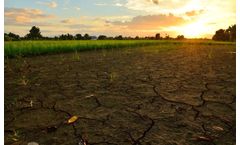Refine by
Soil S Nitrogen Articles & Analysis
27 news found
Does going to the extreme in fertilizer application overcome yield limitations? When it comes to plant development and yield, imbalance is more likely to threaten soil health, production and your pocketbook. Instead, achieving nutrient balance is crucial to crop success. With that in mind, we reflect on the often-perceived conflicting theories – Liebig’s Law of Minimum and ...
Built in collaboration with Bayer's global sustainability team, the badge is awarded to farmers who score high on a sustainable farming practices survey which assigns a score to key farming practices such as no-tillage practices, reduced use of nitrogen, soil management or types of rotation crops. Farmers that do not receive the badge in the first place are ...
ByBayer AG
A recent review paper from Xinda Lu and his team looks at different roles that various soil microbes have in soil’s nitrogen cycle. Lu is a researcher at Massachusetts Institute of Technology. According to Lu, “Soil microbes catalyze most of the transformations of soil ...
But it has the capacity to deliver good protein and energy levels. Which is exactly what’s needed for more litres of milk from forage. And, if you are on a multi-cut system, you may be glad of that extra yield. Unlocking potential from your late-cut grass One of the secrets to unlocking the potential of late-cut grass is to remember that it is growing in different ...
Unlocking the key to silvopastoral systems is especially important in Brazil. The tropical soil cannot support enough plant growth for grazing success. In order to grow enough forage for livestock, nutrients like nitrogen have to be added back into the soil. ...
If digestate is used in the spring on actively growing crops, or other times when there is a crop nitrogen requirement, farmers and growers can significantly increase its nitrogen value. ...
The less nitrogen there is in the soil, the better plants are at using it. Researchers from INRA, CNRS and CIRAD, in cooperation with Czech colleagues, have recently shed light on the crucial role of a protein that enables plants to not only assess their environment but also activate the proper adaptive response based on the conditions. This research, published in the 2 March 2015 issue of Nature ...
Increased soil biodiversity can reduce nitrogen pollution, improve nutrient uptake by plants and even increase crop yields, new research suggests. The two-year study found that levels of nitrogen leaching from soil with an abundant soil life were nearly 25% lower than for soil with a reduced level of soil life. Practices which enhance soil biodiversity such as reduced tilling, crop rotation and ...
The drying of soils under global warming could disrupt the balance of nutrients in large areas of the Earth’s land surface, according to new research. ...
A large-scale research and development project has shown that giving farmers resources and advice on nitrogen fixation through legume plants can double yields and boost incomes in Africa. ...
The drop in nitrogen and carbon concentrations that occurs as soils become dryer could have serious effects on ecosystem services such as food production, carbon storage and biodiversity, according to the Nature paper published today. Loss of nitrogen and carbon, which are the basic building blocks of living organisms, drastically affects ...
Soil nitrogen deficiencies in particular affect approximately 90 percent of African land used to grow rice and other crops. Access to rice varieties that make better use of available nitrogen in soil and respond more effectively to small amounts of fertilizer can help alleviate these agricultural pressures on African farmers and ...
The use of cattle manure in the study led to greater soil fertility by encouraging higher microbial activity, and the researchers suggest that it could potentially improve soil’s ability to cope with periods of difficult growing conditions. ...
Desert soil microbes could help halt desertification and boost agriculture in arid regions of the Middle East and North Africa, according to a study. Scientists from the United Arab Emirates [UAE] have isolated local salt- and drought-tolerant strains of Rhizobia, soil bacteria that fix nitrogen when they become established inside the root nodules of legumes. Rhizobia bacteria establish a ...
Energy crop company Ceres, Inc. (Nasdaq: CERE) today announced that the U.S. Agency for International Development, or USAID, has expanded its grant to the company to develop traits in rice for Asia. Based on Ceres' success to date, USAID will provide an additional $3.5 million to Ceres over the next four years to extend field trialing and development of the company's biotech traits and trait ...
ByCeres
Nitrogen fertilizers from farm fields often end up in aquatic ecosystems, resulting in water quality problems, such as toxic algae and underwater ‘dead zones’. There are concerns that fertilizers used on lawns may also contribute to these problems. All of the lawns in the United States cover an area almost as large as Florida, making turfgrass our largest ‘crop’ and lawn ...
"Ants and termites perform the same ecosystem service functions in dryland agriculture that earthworms perform in cooler and wetter areas, but the potential for ants and termites to provide these benefits has received little attention until now," said CSIRO's Dr Theo Evans. "We already knew that the activities of ants and termites affect soil structure, aeration, water infiltration and nutrient ...
The new business gift program simplifies the process for organizations sending gifts to more than 10 recipients and offers additional benefits. All of Equal Exchange’s gourmet coffee, tea, cocoa, and chocolate are fairly traded, and over 95 percent are also certified organic. ...
Soil scientists studying bacterial communities in hardwood forests have found evidence that extra human-derived nitrogen deposited from the atmosphere can change the composition of the soil microbial community, with implications for carbon cycling and sequestration. ...
Scientists are exploring ways to reduce non-point pollution from agriculture. A new study finds that using straw residue in conjunction with legume cover crops reduces leaching of nitrogen into waterways, but may lower economic return. Agriculture is the largest source of nitrogen non-point pollution to waterways in the United States, flowing into streams and rivers via erosion from farmlands, ...











